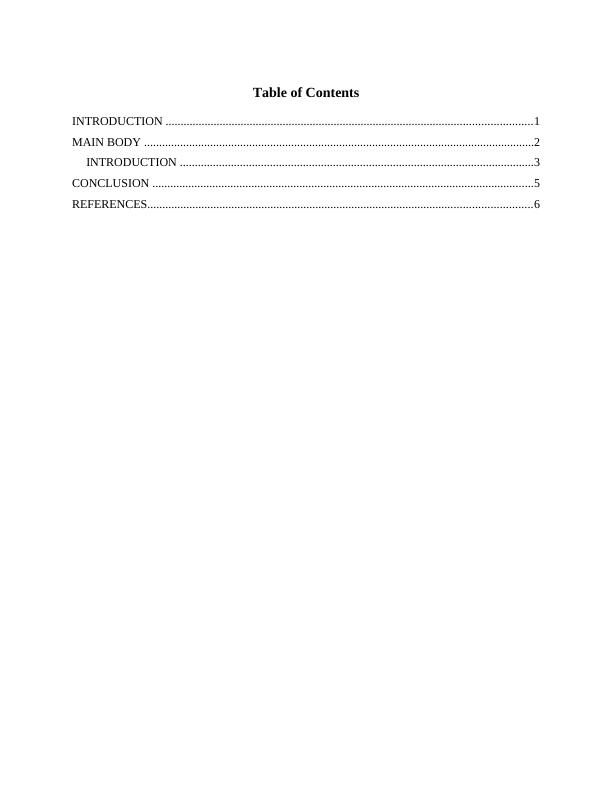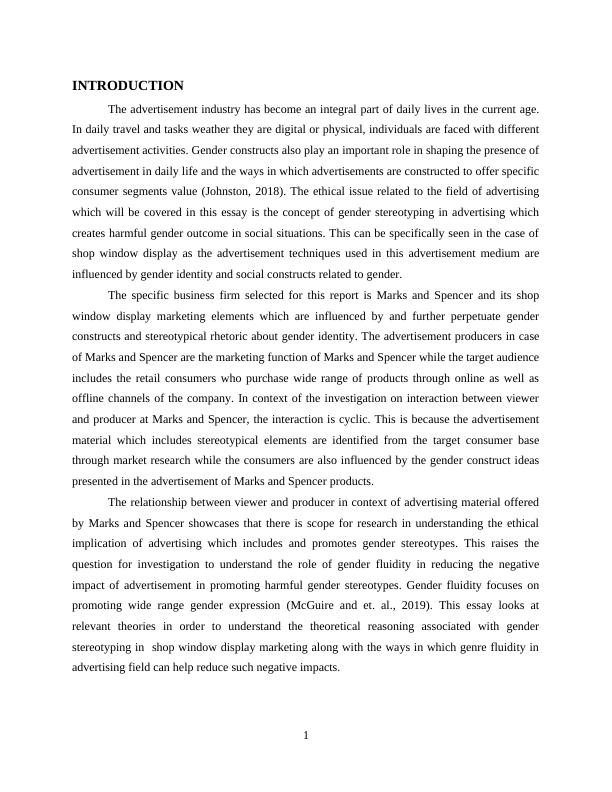Gender Fluidity and Freedom of Expression in Advertising: A Case Study of Marks and Spencer Shop Window Display
Added on 2023-06-11
8 Pages1818 Words220 Views
Gender Fluidity
freedom of
expression
freedom of
expression

Table of Contents
INTRODUCTION ..........................................................................................................................1
MAIN BODY ..................................................................................................................................2
INTRODUCTION ......................................................................................................................3
CONCLUSION ...............................................................................................................................5
REFERENCES................................................................................................................................6
INTRODUCTION ..........................................................................................................................1
MAIN BODY ..................................................................................................................................2
INTRODUCTION ......................................................................................................................3
CONCLUSION ...............................................................................................................................5
REFERENCES................................................................................................................................6

INTRODUCTION
The advertisement industry has become an integral part of daily lives in the current age.
In daily travel and tasks weather they are digital or physical, individuals are faced with different
advertisement activities. Gender constructs also play an important role in shaping the presence of
advertisement in daily life and the ways in which advertisements are constructed to offer specific
consumer segments value (Johnston, 2018). The ethical issue related to the field of advertising
which will be covered in this essay is the concept of gender stereotyping in advertising which
creates harmful gender outcome in social situations. This can be specifically seen in the case of
shop window display as the advertisement techniques used in this advertisement medium are
influenced by gender identity and social constructs related to gender.
The specific business firm selected for this report is Marks and Spencer and its shop
window display marketing elements which are influenced by and further perpetuate gender
constructs and stereotypical rhetoric about gender identity. The advertisement producers in case
of Marks and Spencer are the marketing function of Marks and Spencer while the target audience
includes the retail consumers who purchase wide range of products through online as well as
offline channels of the company. In context of the investigation on interaction between viewer
and producer at Marks and Spencer, the interaction is cyclic. This is because the advertisement
material which includes stereotypical elements are identified from the target consumer base
through market research while the consumers are also influenced by the gender construct ideas
presented in the advertisement of Marks and Spencer products.
The relationship between viewer and producer in context of advertising material offered
by Marks and Spencer showcases that there is scope for research in understanding the ethical
implication of advertising which includes and promotes gender stereotypes. This raises the
question for investigation to understand the role of gender fluidity in reducing the negative
impact of advertisement in promoting harmful gender stereotypes. Gender fluidity focuses on
promoting wide range gender expression (McGuire and et. al., 2019). This essay looks at
relevant theories in order to understand the theoretical reasoning associated with gender
stereotyping in shop window display marketing along with the ways in which genre fluidity in
advertising field can help reduce such negative impacts.
1
The advertisement industry has become an integral part of daily lives in the current age.
In daily travel and tasks weather they are digital or physical, individuals are faced with different
advertisement activities. Gender constructs also play an important role in shaping the presence of
advertisement in daily life and the ways in which advertisements are constructed to offer specific
consumer segments value (Johnston, 2018). The ethical issue related to the field of advertising
which will be covered in this essay is the concept of gender stereotyping in advertising which
creates harmful gender outcome in social situations. This can be specifically seen in the case of
shop window display as the advertisement techniques used in this advertisement medium are
influenced by gender identity and social constructs related to gender.
The specific business firm selected for this report is Marks and Spencer and its shop
window display marketing elements which are influenced by and further perpetuate gender
constructs and stereotypical rhetoric about gender identity. The advertisement producers in case
of Marks and Spencer are the marketing function of Marks and Spencer while the target audience
includes the retail consumers who purchase wide range of products through online as well as
offline channels of the company. In context of the investigation on interaction between viewer
and producer at Marks and Spencer, the interaction is cyclic. This is because the advertisement
material which includes stereotypical elements are identified from the target consumer base
through market research while the consumers are also influenced by the gender construct ideas
presented in the advertisement of Marks and Spencer products.
The relationship between viewer and producer in context of advertising material offered
by Marks and Spencer showcases that there is scope for research in understanding the ethical
implication of advertising which includes and promotes gender stereotypes. This raises the
question for investigation to understand the role of gender fluidity in reducing the negative
impact of advertisement in promoting harmful gender stereotypes. Gender fluidity focuses on
promoting wide range gender expression (McGuire and et. al., 2019). This essay looks at
relevant theories in order to understand the theoretical reasoning associated with gender
stereotyping in shop window display marketing along with the ways in which genre fluidity in
advertising field can help reduce such negative impacts.
1

End of preview
Want to access all the pages? Upload your documents or become a member.
